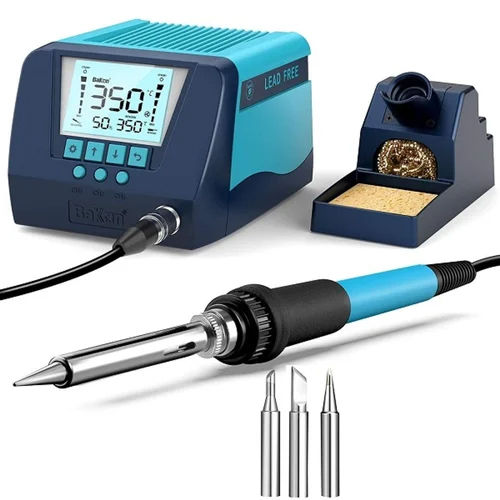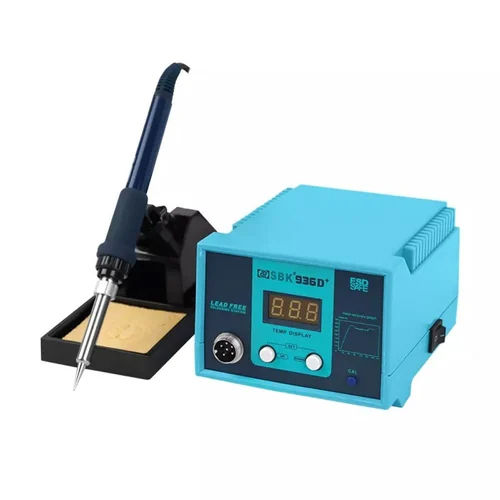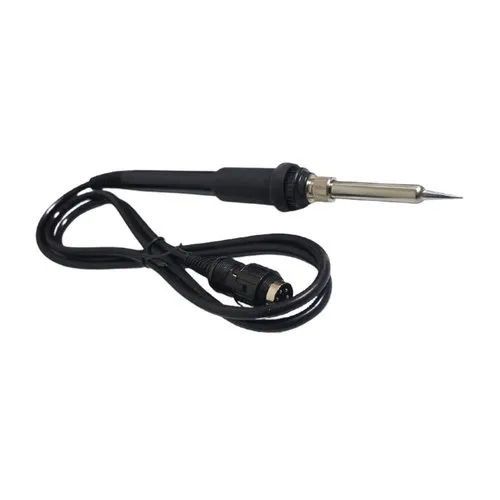Automatic Soldering Iron
Product Details:
- Operating Voltage 220V - 240V Volt (V)
- Width 3 Centimeter (cm)
- Application Soldering, Reworking, Electronics Repair
- Length 18 Centimeter (cm)
- Product Type Automatic Soldering Iron
- Color Blue-Black-Silver
- Height 4 Centimeter (cm)
- Click to View more
Automatic Soldering Iron Price And Quantity
- 5 Piece
- 330 INR/Piece
Automatic Soldering Iron Product Specifications
- 18 Centimeter (cm)
- Industrial
- Blue-Black-Silver
- 4 Centimeter (cm)
- Automatic Soldering Iron
- 3 Centimeter (cm)
- 220V - 240V Volt (V)
- Soldering, Reworking, Electronics Repair
Automatic Soldering Iron Trade Information
- Cash Advance (CA), Cash in Advance (CID)
- 5000 Piece Per Month
- 3 Days
- Yes
- Sample costs shipping and taxes has to be paid by the buyer
- as per customer requirement
- All India
Product Description
Automation Grade - Automatic
Handle Material - PVC
Power Source - Electric
An automatic soldering iron (or more broadly, an automatic soldering machine or robotic soldering system) is a sophisticated device designed to automate the process of joining electronic components or metal parts using solder. Unlike traditional manual soldering irons that require an operator to physically feed solder and apply heat, automatic soldering irons integrate mechanisms for precise solder delivery and controlled heating, often with robotic arms for highly accurate and repeatable movements.
Here's a breakdown of its description, how it works, and its key features:
Description and Purpose:
The primary purpose of an automatic soldering iron is to enhance precision, consistency, speed, and efficiency in soldering tasks, especially in manufacturing environments. It significantly reduces human error, improves product quality, and increases productivity in high-volume production. These systems can range from simpler handheld irons with an integrated solder feeder to complex multi-axis robotic systems.
How it Works:
The operation of an automatic soldering iron or system typically involves several integrated steps:
- Programming: For robotic systems, the soldering path, temperature profiles, solder wire feeding length and speed, and other parameters are programmed using specialized software. This can be based on 3D models of the components or through "teach-in" methods where an operator guides the robot through the desired movements.
- Component Placement (for automated systems): In fully automated setups, components are accurately positioned on the Printed Circuit Board (PCB) or other workpieces, often by pick-and-place machines, before soldering.
- Fluxing (if not flux-cored solder): A chemical solution called flux is applied to the metal surfaces. Flux cleans the surfaces by removing oxides and impurities, allowing the solder to flow and form a strong bond. Many automatic systems use flux-cored solder wire, eliminating the need for separate flux application.
- Preheating (optional but common): The workpiece might be preheated to a specific temperature to ensure uniform solder flow and prevent thermal shock to delicate components.
- Soldering:
- Automated Solder Feed: A motor-driven mechanism precisely feeds a predetermined amount of solder wire to the soldering tip. Some systems even perforate the solder wire to improve flux flow and prevent solder balls.
- Controlled Heating: The soldering iron's tip is heated to a precise temperature, often with PID control for excellent stability and accuracy. This ensures the solder melts and wets the joint effectively.
- Precise Application: Robotic arms, if present, move the heated soldering iron tip to the exact solder joint location with high repeatability. The contact force and dwell time can be carefully controlled.
- Automated Solder Feed: A motor-driven mechanism precisely feeds a predetermined amount of solder wire to the soldering tip. Some systems even perforate the solder wire to improve flux flow and prevent solder balls.
- Cooling and Solidification: Once the solder is applied, it cools and solidifies, forming a strong electrical and mechanical bond between the components and the base material.
- Quality Control (optional): Advanced systems may integrate vision systems to inspect the solder joints for defects, ensuring high-quality output.
Key Features:
Automatic soldering irons and systems boast a range of features designed for precision and efficiency:
- Automated Solder Feeding: The most defining feature, allowing one-handed operation and consistent solder delivery. This often includes adjustable feeding speed and length.
- Temperature Control: Precise and adjustable temperature control, often with digital displays and PID algorithms, to suit different solder types and components.
- Programmable Operation: For robotic systems, the ability to program complex soldering paths, parameters (temperature, solder amount, speed), and multiple soldering points.
- Multi-Axis Movement (for robots): Robotic arms with multiple axes (e.g., X, Y, Z, R for rotation) provide flexibility to reach intricate or hard-to-access solder joints.
- High Precision and Repeatability: Capable of achieving extremely accurate solder joints consistently, minimizing human error and variability.
- Fast Heating and Recovery: Quick heat-up times and rapid temperature recovery ensure efficient continuous operation.
- Vision Systems (for advanced robots): Integrated cameras and sensors to identify solder points, align the iron, and inspect finished joints.
- Flexible Manipulators: Robotic arms designed to rotate, extend, and bend for optimal maneuverability.
- Solder Wire Perforation: Some systems perforate the solder wire to enhance flux activation and reduce solder splatter.
- User-Friendly Interface: Often includes teach pendants or software interfaces for easy programming and monitoring.
- Safety Features: Automatic shut-off, fume extraction integration, and robust mechanical designs for safe operation.
- Compatibility: Designed to work with various solder wire diameters and tip types.
- Durability and Quality Construction: Built with high-quality materials to withstand continuous operation and high temperatures.
In essence, an automatic soldering iron or machine transforms a traditionally manual and often inconsistent process into a highly precise, efficient, and repeatable operation, crucial for modern electronics manufacturing.
Other Products in 'Soldering Iron' category
GST : 24AFJFS1863D1Z2
|
|
|
|
 |
SHRI NATH ELECTROTECH
All Rights Reserved.(Terms of Use) Developed and Managed by Infocom Network Private Limited. |











